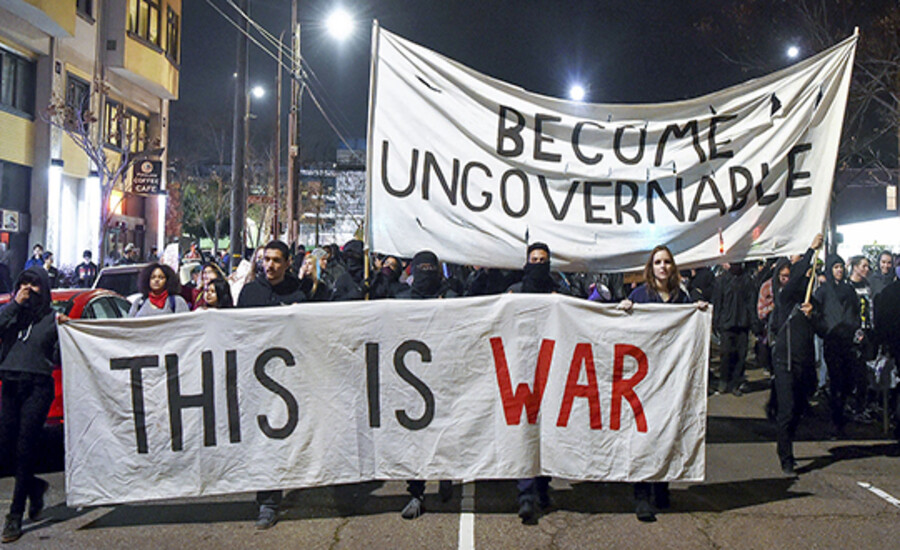
JOSH EDELSON/AFP/GETTY IMAGES
Communism Is Conquering Academia
"Marxism is dead everywhere except American universities.” That was the wry joke some told after the Soviet Union fell in 1991, at the end of a century in which 100 million people were killed in the name of communism. But 29 years later, communism has spread from the fringes of academia into mainstream education. Millions of former and current college students now support radical candidates and radical demands for America’s future.
In 2006, about 3 percent of American professors said they were Marxists, according to a national survey conducted by Neil Gross of Harvard University and Solon Simmons of George Mason University. Within the social sciences—a field partially fathered by Karl Marx—that number was 18 percent—nearly 1 in 5.
The number of professors who admit to being more socialist than conservative has risen from 43 percent in 1970 to around 60 percent today, according to the American Institute for Economic Research. And the number of professors who admit to being “far left” has more than doubled, rising from 5 percent to 12 percent. Beyond these, however, many more professors follow the advice of leading socialist thinkers by masquerading as moderates.
Whether professors admit it or not, Marxist-Leninism is now the dominant model of history and society being taught in American universities. Under labels like “post-colonialism,” “anti-neoliberalism” and “social justice,” professors are teaching that the American narrative about individual liberty and limited government is a mask for the power of wealthy, white, European males. They tout alternative histories like Howard Zinn’s Marxist-inspired textbook A People’s History of the United States. This is why millennials are increasingly embracing socialism over capitalism.
How did communism become so strong in American academia?
During the Cold War, a Soviet Union spy named Yuri Bezmenov defected and escaped to Canada. He revealed that the kgb spy agency considered subverting nations so important that it allocated most of its resources to the project. “Only about 15 percent of time, money and manpower is spent on espionage as such,” he explained in an interview with G. Edward Griffin in 1985. “The other 85 percent is a slow process, which we call either ideological subversion or ‘active measures.’”
This “ideological subversion,” Bezmenov said, is a long process involving four stages: demoralization, destabilization, crisis and normalization. The first stage, demoralization, is now a familiar concept. Many who recognize America’s obvious demoralization in the 20th century think it occurred accidentally, naturally or even fortunately. But former kgb agents, said Bezmenov, recognize it as an intentional attack designed to “change the perception of reality of every American” and destroy the country.
“It takes about 15 to 20 years to demoralize a nation,” Bezmenov wrote in his book, Love Letter to America. “Why that many (or few)? Simple: This is the minimum number of years needed to ‘educate’ one generation of students in a target country (America, for example) and expose them to the ideology of the subverter.”
Bezmenov warned—again, in 1985—that kgb agents and their socialist sympathizers would use abstract art, perverted music, pornographic images, homosexual activism, accusations of racism, pacifist foreign policy and socialist economics to demoralize America. Whether you believe him or not, does this sound familiar?
The obvious objective of socialists is to destroy America’s morals, traditions, institutions and laws, and to conquer it with socialist ideology, policies and enforcement. It is now obvious to many that socialists recognized the importance of American education when many conservatives did not.
According to a former staff director of a Senate investigations subcommittee, in the years between 1935 and 1953, the Communist Party “enlisted the support of at least 3,500 professors—many of them as dues-paying members, many others as fellow travelers, some as out-and-out espionage agents, some as adherents of the party line in varying degrees, and some as the unwitting dupes of subversion” (J. B. Matthews, “Communism and the Colleges,” American Mercury, May 1953).
The Communist ideology introduced to America has spread throughout the university system and is beginning to dominate high schools and even elementary schools. This fact is more significant than you might realize. Bezmenov warned that the end goal was to “change the perception of reality of every American to such an extent that despite the abundance of information, no one is able to come to sensible conclusions in the interest of defending themselves, their families, their community and their country.” You could argue that this goal has been reached.
